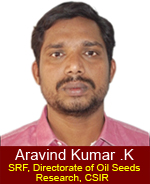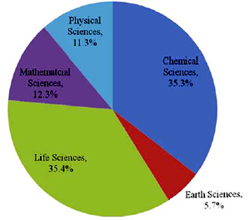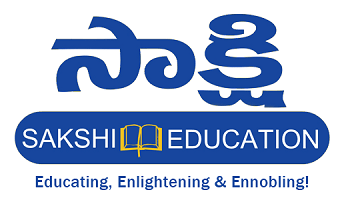CSIR-UGC Net in Life Sciences – This is How You Crack It!!
Sakshi Education

The Council of Scientific and Industrial Research (CSIR) initiated a research fellowship scheme in 1983 to recognize young talent with passion for scientific research. With this objective, the CSIR started a national level competitive exam - National Eligibility Test (NET) to provide financial assistance in the form Junior Research Fellowship (JRF) to candidates interested in pursuing PhD in academic and scientific institutions across the country.
 The award of Junior Research Fellowships (JRFs) through NET is being shared with the University Grants Commission (UGC) since 1986 and the later body also agreed to recognise NET as eligibility for Lectureship. Subsequently, in 1989 the exam was reorganised into “CSIR–UGC National Eligibility Test”. Thus, CSIR-UGC NET emerged as single largest exam for determining the eligibility for both Junior Research Fellowship and Eligibility for Lectureship.
The award of Junior Research Fellowships (JRFs) through NET is being shared with the University Grants Commission (UGC) since 1986 and the later body also agreed to recognise NET as eligibility for Lectureship. Subsequently, in 1989 the exam was reorganised into “CSIR–UGC National Eligibility Test”. Thus, CSIR-UGC NET emerged as single largest exam for determining the eligibility for both Junior Research Fellowship and Eligibility for Lectureship.
Since then CSIR-UGC NET is conducted twice a year in June and December. Notification for Joint CSIR-UGC NET to be conducted in June 2014 has been already advertised. (For details of the notification, last date, syllabus and scheme of the exam candidates may visit CSIR website: www.csirhrdg.res.in.)
Fellowship and Lectureship
Candidates qualified in the above test are grouped into two separate merit lists viz. – JRF List and NET List. Candidates who got into first merit list will be awarded Junior Research Fellowships, along with eligibility for Lectureship. Those who made into second merit list would be awarded only eligibility for Lectureship (NET), except in Engineering sciences. The NET candidates will be given preference in other schemes and projects, in which JRFs are available.
Age Limit
For JRF–NET, 28 years is the age limit and there is no age limit for NET Lectureship. A five-year age relaxation is given to candidates belonging to Scheduled Castes (SC), Scheduled Tribes (ST), Other Backward Classes (OBC), Physically Handicapped (PH) and women candidates.
Paper Format
Part A is common to all subjects including Engineering Sciences. This part contains questions pertaining to General Aptitude with emphasis on logical reasoning, graphical analysis, analytical and numerical ability, quantitative comparison, series formation, puzzles etc.
Part B contains subject-related conventional Multiple Choice questions (MCQs), generally covering the topics given in the syllabus.
Part 'C' shall contain higher value questions that may test the candidate's knowledge of scientific concepts and/or application of the scientific concepts. The questions shall be of analytical nature where a candidate is expected to apply the scientific knowledge to arrive at the solution to the given scientific problem.
In Engineering Sciences, Part ‘B’ shall contain questions pertaining to Mathematics & Engineering.
Aptitude & Part ‘C’ shall contain subject related multiple choice questions (MCQs), generally covering the topics in the syllabus.
Negative marking for wrong answers, wherever required, shall be applicable as per scheme of Exam.
Tenure of Fellowship
 Currently the fellowship is being given for the tenure of 5 years. For first two years of research the fellow is considered as a Junior Research Fellow (JRF) and for next three years the fellow is considered as a Senior Research Fellow (SRF). The JRF holders get a stipend of Rs. 16,000 + HRA every month and SRF holders are given a monthly stipend of Rs. 18,000 + HRA. An Annual contingency grant of Rs 20,000 is also granted. Every year, on an average 1300 fellowships are being offered by CSIR, of which almost one-third are granted to the life science students.
Currently the fellowship is being given for the tenure of 5 years. For first two years of research the fellow is considered as a Junior Research Fellow (JRF) and for next three years the fellow is considered as a Senior Research Fellow (SRF). The JRF holders get a stipend of Rs. 16,000 + HRA every month and SRF holders are given a monthly stipend of Rs. 18,000 + HRA. An Annual contingency grant of Rs 20,000 is also granted. Every year, on an average 1300 fellowships are being offered by CSIR, of which almost one-third are granted to the life science students.
Massive Syllabus?
CSIR –UGC Fellowship Exam in Life Sciences is regarded as the toughest exam in the category. The design of the exam not only aims at testing the subject knowledge but also the aptitude for scientific analysis. Paper is common for all students pursuing Masters and B.Tech. programmes in various streams in the life sciences category. Recently, B.Pharma. programme has also been given eligibility in this category. Hence design of the paper is unique in accommodating questions from different subjects giving equal opportunities to students from all Life Sciences. Therefore, the syllabus appears very broad as it includes all the subjects in life sciences category. Due to this, sometimes students find it very difficult to cover the huge syllabus. In fact, most of the students get discouraged just by looking at the quantum of the syllabus and give up their hopes at the very beginning. This has become a major drawback of the students pertaining to this exam. However, going by the aforementioned facts, if one thinks that clearing CSIR-UGC NET exam is difficult, it is absolutely wrong.
Syllabus Justified, Solve Your Problems!
Since the exam is meant for all the Life Science students, structure of the paper and the syllabus is justified. So, keeping that point aside, one should have a clear preparation strategy in order to crack the exam. Generally, students can have sufficient knowledge only in the subject of their master’s programme such as Botany, Zoology, Genetics, Microbiology, Biochemistry and Biotechnology, among others. It is also true that the students would be busy for two years in getting command over the specialised subject. This makes student’s task difficult to get decent grip over other life science subjects.
It will be much more difficult when a student studying particular subject for example Botany or Zoology in graduation and then shifts to another subject in the masters programme, say Biochemistry or Microbiology. It is not surprising that these courses start straight away without considering or providing basics for such students. The problem becomes more intense when such students join further difficult courses like Biotechnology which includes applications from all the life sciences subjects.
Students feel it difficult to understand the concepts because either they lack exposure to those concepts at their graduation level or they have to master basics during their post-graduation. To add to their vows, it is absolutely difficult to find a text book which explains both basics and application part of the subjects. So the students have to struggle in getting the concepts by studying multiple books. This is definitely a time consuming task.
The hectic schedules of the universities also force students to adopt a policy, which prefers marks than mastering the basic concepts. The pattern of the exams followed in the state universities do not really test the analytical skills of the students but are based more on the theoretical aspects. Thus, students are streamlined to focus more on theoretical aspects, which is an exactly opposite pattern of national level exams that students have to face right after their graduation or post graduation.
Ultimately majority of the students end up in learning half-baked concepts. It is not overstating to say that some of the toppers from the state universities are failing constantly not only to clear national level exams like CSIR-JRF, DBT-JRF etc., but are also struggling to achieve even Lectureship eligibility. In addition, some students who have studied in Telugu medium up to +2 or graduation find it as a daunting task to qualify such exams. Now that majority of the exams have removed description part from the question paper except ARS, it is a sigh of relief for such students.
Proper Planning Required
CSIR exam also includes questions from basic concepts from Maths, Physics, Chemistry and Biological Sciences. It is obvious that a Life science graduate or post graduate will be comfortable with biological sciences. Problem comes with non-biology subjects. Since in our education system, bifurcation of students studying maths and life sciences occurs early in Intermediate, it will be difficult to expect the students to score in Mathematics. However students especially who studied Maths as a subject up to 10+2 are comfortable are advised to go through the previous papers and practice questions from some easily scorable topics. Even 2-3 marks scored in the area can play a differentiating role. It should be taken care that they do not spend much time and preferably do it after covering enough portions of biology.
Nevertheless, students uncomfortable with Mathematics should not get disheartened. They can just ignore it and concentrate on other areas which they feel better and try to make up the loss. But knowledge of Statistics is very essential for future researchers. Hence, this subject shall be given special attention.
Physics is a part up to 10+2, hence students shall try to get the grip of this subject. However, here, concepts of physics are asked as applications of biological sciences. Topics like thermodynamics help students understanding why ATP is the major source of energy in the cells. Topics like Colligative Properties enable the students to understand why Plant cells contain cell wall and animal cells do not? Why Glucose cannot be stored as such in the cells and has to be converted into Glycogen or starch?
Chemistry is the part of 3 year graduation course and is an indispensable part of biology as living cells obeys chemicals laws. It is not essential for the students to know the entire Chemistry, but requires a good knowledge of some topics like Solutions, Acids and Bases, Electrochemistry and Chemical kinetics etc. These topics are a part of Intermediate also. As a researcher one has to work with solutions on a day to day basis. Knowledge of chemical bonds, energetics and kinetics help the students to comprehend why glucose, a six carbon molecule, has to undergo ten reactions to produce two 3 carbon molecules which can be done in a single reaction theoretically. Thus concepts of Glycolysis, a part of Biochemistry and similarly Photosynthesis, a part of plant physiology become clear. Atomic size and ionic mobilities will help in knowing the reason behind high concentration of sodium (Na+) ions outside a cell whereas concentration of potassium ions (K+) is high inside the cells. It also explains why the same transporter carries 3 sodium ions outside and only two potassium ions inside. Thus Cell biology concepts like membrane transport become clearer. Consequently roots of some Biology aspects lie in Chemistry. After all chemistry is the language of Biologists.
Strategy for Life Science Topics - What and Where to Start?
Any student preparing for CSIR-UGC Exam should start preparing for the exam by starting the topics like Cell Biology first since it is a part of the high school syllabus and common portion in both Botany and Zoology both at intermediate and graduation level. Cell biology is a compulsory aspect for all Life Science students, hence, it is the easiest choice to start the preparation.
Cell Biology is included in CSIR syllabus in 2 parts - Cell organization and Cell Signaling/Communication. Studying celluar organization will help the student in understanding the structure and function of the cells. Basic knowledge of how a Bacterial cell (Prokaryote) differs from a plant cell or animal cell can be acquired. A student having strong concepts in cell biology will not find it easy to study plant biochemistry/biotechnology or animal biochemistry/biotechnology. It also enables the students to appreciate the basic concepts in biochemistry for example- why Krebs Cycle occurs only in Mitochondria and not in Cytoplasm.
After Cell Biology, Molecular Biology is right option. Molecular Biology will help the students learning fundamental procedures like structure of DNA, RNA, transcription and translation etc., A student well versed in cell and molecular biology will easily understand the difference between B-cell and T-cell and the difference between leucocytes and lymphocyte and B-cell and a plasma cell. Thus the realization of Immunology concepts will become easy.
Basic Biochemistry is another crucial part in CSIR exam. It is very essential that topics like amino acids, carbohydrates, lipids and proteins, vitamins, hormones are studied well. These topics don’t require much analysis and can be learned easily with little hard work. Enzymology is another crucial part that every student must study. Topics like metabolism of amino acids, carbohydrates and lipids can be difficult for students who are not specialized in biochemistry. Therefore it is upto the individuals depending on their interest and time, whether to study these topics or not. While studying any biochemical pathway, the regulatory steps have to be focused. However, it is essential to study energy production pathways like Glycolysis, Kreb’s Cycle and electron transport chain, photosynthesis (PS I and PS II), C3 , C4 cycles etc., should be emphasized and are included in System Biology (Plant).
Along with Biochemistry, basic genetics forms an inevitable portion of syllabus which is crucial. Mendelian genetics and its extensions which include laws of inheritance, gene interactions, linkage and crossover, sex determination and sex linked inheritance are important. However, for students not specialized in genetics qualitative and human genetics can be ignored. But topics like mutations and recombination are Important.
Having studied Molecular Biology and basic genetics, applications of these areas form the core for Recombinant DNA technology. Thus gene cloning, vectors and sequencing techniques can be learnt with ease. After learning techniques like PCR, applications of PCR like RAPD, AFLP etc., become much simpler.
Simultaneously biophysical techniques, radiolabelling techniques, histochemical and immunotechniques and microscopic techniques can be learnt easily. While learning these techniques, students shall focus up on the principle of each technique and its applications.
This also forms platform for students to know about applied biology. General microbiology which includes structure of prokaryotic cells, growth curves and kinetics are also essential. Fermentation technology forms an important topic to study. However applications of microbiology food, water, air microbiology are optional.
Subjects like System Physiology, Ecology and Evolution are more based on theory, can be learnt by directly reading standard text books. Ecology and Evolution has to be given a special emphasis as traditionally more number of questions have appeared from these areas and are not a part of regular syllabus for many courses. Thus by following a clear strategy one can qualify in CSIR-UGC exam with ease. Early awareness and early preparation right from first year of Post graduation or third year of B.Tech or B.Pharma., success can be rest assured.
List of Recommended Books
Cell Biology
Molecular Biology of the Cell by Bruce Alberts.
Molecular Cell Biology by Harvey Lodish
Molecular Biology-
Molecular Biology by David Freifelder
Lewin's Genes X by Jocelyn E. Krebs, Elliott S. Goldstein and Stephen T. Kilpatrick
Immunology-
Kuby Immunology by Thomas J. Kindt, Barbara A. Osborne and Richard A. Goldsby.
Essential Immunology by Ivan Roitt.
Biochemistry-
Lehninger Principles of Biochemistry by Albert L. Lehninger
Fundamentals of Biochemistry by Donald Voet and Judith G. Voet
Biochemistry by Lubert Stryer
Genetics-
Principles of Genetics by Gardner, Simmons and Snustad
An Introduction to Genetic Analysis by Anthony J.F. Griffiths
Genetics by Monroe W. Strickberger
Recombinant DNA Technology
Principles of Gene Manipulation and Genomics by Sandy B. Primrose and Richard Twyman
From Genes to Clones: Introduction to Gene Technology by Ernst L. Winnacker
Microbiology
Microbiology by Pelczar
Brock Biology of Microorganisms by John M. Martinko and David A. Stahl
Microbiology: Fundamentals and Applications by Ronald M. Atlas
Principles of Fermentation Technology by Peter F. Stanbury, Allan Whitaker and Stephen J. Hall
Industrial Microbiology by L.E. Casida
Plant Physiology
Plant Physiology by Lincoln Taiz, Eduardo Zeiger
Plant Physiology by Frank B. Salisbury, Cleon W. Ross
Developmental Biology
Developmental Biology by Scott F. Gilbert
Animal Physiology
Principles of Animal Physiology by C. D. Moyes and P. M. Schulte
Ecology and Evolution
Ecology byP.D. Sharma
Ecology by Smith and Smith
Evolution by Monroe W. Strickberger
Basic Ecology by P. Odum.
Statistics
Comprehensive Statistical Methods by P.N. Arora, Sumeet Arora, S. Arora and Amit Arora
 The award of Junior Research Fellowships (JRFs) through NET is being shared with the University Grants Commission (UGC) since 1986 and the later body also agreed to recognise NET as eligibility for Lectureship. Subsequently, in 1989 the exam was reorganised into “CSIR–UGC National Eligibility Test”. Thus, CSIR-UGC NET emerged as single largest exam for determining the eligibility for both Junior Research Fellowship and Eligibility for Lectureship.
The award of Junior Research Fellowships (JRFs) through NET is being shared with the University Grants Commission (UGC) since 1986 and the later body also agreed to recognise NET as eligibility for Lectureship. Subsequently, in 1989 the exam was reorganised into “CSIR–UGC National Eligibility Test”. Thus, CSIR-UGC NET emerged as single largest exam for determining the eligibility for both Junior Research Fellowship and Eligibility for Lectureship. Since then CSIR-UGC NET is conducted twice a year in June and December. Notification for Joint CSIR-UGC NET to be conducted in June 2014 has been already advertised. (For details of the notification, last date, syllabus and scheme of the exam candidates may visit CSIR website: www.csirhrdg.res.in.)
Fellowship and Lectureship
Candidates qualified in the above test are grouped into two separate merit lists viz. – JRF List and NET List. Candidates who got into first merit list will be awarded Junior Research Fellowships, along with eligibility for Lectureship. Those who made into second merit list would be awarded only eligibility for Lectureship (NET), except in Engineering sciences. The NET candidates will be given preference in other schemes and projects, in which JRFs are available.
Age Limit
For JRF–NET, 28 years is the age limit and there is no age limit for NET Lectureship. A five-year age relaxation is given to candidates belonging to Scheduled Castes (SC), Scheduled Tribes (ST), Other Backward Classes (OBC), Physically Handicapped (PH) and women candidates.
Paper Format
Part A is common to all subjects including Engineering Sciences. This part contains questions pertaining to General Aptitude with emphasis on logical reasoning, graphical analysis, analytical and numerical ability, quantitative comparison, series formation, puzzles etc.
Part B contains subject-related conventional Multiple Choice questions (MCQs), generally covering the topics given in the syllabus.
Part 'C' shall contain higher value questions that may test the candidate's knowledge of scientific concepts and/or application of the scientific concepts. The questions shall be of analytical nature where a candidate is expected to apply the scientific knowledge to arrive at the solution to the given scientific problem.
In Engineering Sciences, Part ‘B’ shall contain questions pertaining to Mathematics & Engineering.
Aptitude & Part ‘C’ shall contain subject related multiple choice questions (MCQs), generally covering the topics in the syllabus.
Negative marking for wrong answers, wherever required, shall be applicable as per scheme of Exam.
Tenure of Fellowship
 Currently the fellowship is being given for the tenure of 5 years. For first two years of research the fellow is considered as a Junior Research Fellow (JRF) and for next three years the fellow is considered as a Senior Research Fellow (SRF). The JRF holders get a stipend of Rs. 16,000 + HRA every month and SRF holders are given a monthly stipend of Rs. 18,000 + HRA. An Annual contingency grant of Rs 20,000 is also granted. Every year, on an average 1300 fellowships are being offered by CSIR, of which almost one-third are granted to the life science students.
Currently the fellowship is being given for the tenure of 5 years. For first two years of research the fellow is considered as a Junior Research Fellow (JRF) and for next three years the fellow is considered as a Senior Research Fellow (SRF). The JRF holders get a stipend of Rs. 16,000 + HRA every month and SRF holders are given a monthly stipend of Rs. 18,000 + HRA. An Annual contingency grant of Rs 20,000 is also granted. Every year, on an average 1300 fellowships are being offered by CSIR, of which almost one-third are granted to the life science students.Massive Syllabus?
CSIR –UGC Fellowship Exam in Life Sciences is regarded as the toughest exam in the category. The design of the exam not only aims at testing the subject knowledge but also the aptitude for scientific analysis. Paper is common for all students pursuing Masters and B.Tech. programmes in various streams in the life sciences category. Recently, B.Pharma. programme has also been given eligibility in this category. Hence design of the paper is unique in accommodating questions from different subjects giving equal opportunities to students from all Life Sciences. Therefore, the syllabus appears very broad as it includes all the subjects in life sciences category. Due to this, sometimes students find it very difficult to cover the huge syllabus. In fact, most of the students get discouraged just by looking at the quantum of the syllabus and give up their hopes at the very beginning. This has become a major drawback of the students pertaining to this exam. However, going by the aforementioned facts, if one thinks that clearing CSIR-UGC NET exam is difficult, it is absolutely wrong.
Syllabus Justified, Solve Your Problems!
Since the exam is meant for all the Life Science students, structure of the paper and the syllabus is justified. So, keeping that point aside, one should have a clear preparation strategy in order to crack the exam. Generally, students can have sufficient knowledge only in the subject of their master’s programme such as Botany, Zoology, Genetics, Microbiology, Biochemistry and Biotechnology, among others. It is also true that the students would be busy for two years in getting command over the specialised subject. This makes student’s task difficult to get decent grip over other life science subjects.
It will be much more difficult when a student studying particular subject for example Botany or Zoology in graduation and then shifts to another subject in the masters programme, say Biochemistry or Microbiology. It is not surprising that these courses start straight away without considering or providing basics for such students. The problem becomes more intense when such students join further difficult courses like Biotechnology which includes applications from all the life sciences subjects.
Students feel it difficult to understand the concepts because either they lack exposure to those concepts at their graduation level or they have to master basics during their post-graduation. To add to their vows, it is absolutely difficult to find a text book which explains both basics and application part of the subjects. So the students have to struggle in getting the concepts by studying multiple books. This is definitely a time consuming task.
The hectic schedules of the universities also force students to adopt a policy, which prefers marks than mastering the basic concepts. The pattern of the exams followed in the state universities do not really test the analytical skills of the students but are based more on the theoretical aspects. Thus, students are streamlined to focus more on theoretical aspects, which is an exactly opposite pattern of national level exams that students have to face right after their graduation or post graduation.
Ultimately majority of the students end up in learning half-baked concepts. It is not overstating to say that some of the toppers from the state universities are failing constantly not only to clear national level exams like CSIR-JRF, DBT-JRF etc., but are also struggling to achieve even Lectureship eligibility. In addition, some students who have studied in Telugu medium up to +2 or graduation find it as a daunting task to qualify such exams. Now that majority of the exams have removed description part from the question paper except ARS, it is a sigh of relief for such students.
Proper Planning Required
CSIR exam also includes questions from basic concepts from Maths, Physics, Chemistry and Biological Sciences. It is obvious that a Life science graduate or post graduate will be comfortable with biological sciences. Problem comes with non-biology subjects. Since in our education system, bifurcation of students studying maths and life sciences occurs early in Intermediate, it will be difficult to expect the students to score in Mathematics. However students especially who studied Maths as a subject up to 10+2 are comfortable are advised to go through the previous papers and practice questions from some easily scorable topics. Even 2-3 marks scored in the area can play a differentiating role. It should be taken care that they do not spend much time and preferably do it after covering enough portions of biology.
Nevertheless, students uncomfortable with Mathematics should not get disheartened. They can just ignore it and concentrate on other areas which they feel better and try to make up the loss. But knowledge of Statistics is very essential for future researchers. Hence, this subject shall be given special attention.
Physics is a part up to 10+2, hence students shall try to get the grip of this subject. However, here, concepts of physics are asked as applications of biological sciences. Topics like thermodynamics help students understanding why ATP is the major source of energy in the cells. Topics like Colligative Properties enable the students to understand why Plant cells contain cell wall and animal cells do not? Why Glucose cannot be stored as such in the cells and has to be converted into Glycogen or starch?
Chemistry is the part of 3 year graduation course and is an indispensable part of biology as living cells obeys chemicals laws. It is not essential for the students to know the entire Chemistry, but requires a good knowledge of some topics like Solutions, Acids and Bases, Electrochemistry and Chemical kinetics etc. These topics are a part of Intermediate also. As a researcher one has to work with solutions on a day to day basis. Knowledge of chemical bonds, energetics and kinetics help the students to comprehend why glucose, a six carbon molecule, has to undergo ten reactions to produce two 3 carbon molecules which can be done in a single reaction theoretically. Thus concepts of Glycolysis, a part of Biochemistry and similarly Photosynthesis, a part of plant physiology become clear. Atomic size and ionic mobilities will help in knowing the reason behind high concentration of sodium (Na+) ions outside a cell whereas concentration of potassium ions (K+) is high inside the cells. It also explains why the same transporter carries 3 sodium ions outside and only two potassium ions inside. Thus Cell biology concepts like membrane transport become clearer. Consequently roots of some Biology aspects lie in Chemistry. After all chemistry is the language of Biologists.
Strategy for Life Science Topics - What and Where to Start?
Any student preparing for CSIR-UGC Exam should start preparing for the exam by starting the topics like Cell Biology first since it is a part of the high school syllabus and common portion in both Botany and Zoology both at intermediate and graduation level. Cell biology is a compulsory aspect for all Life Science students, hence, it is the easiest choice to start the preparation.
Cell Biology is included in CSIR syllabus in 2 parts - Cell organization and Cell Signaling/Communication. Studying celluar organization will help the student in understanding the structure and function of the cells. Basic knowledge of how a Bacterial cell (Prokaryote) differs from a plant cell or animal cell can be acquired. A student having strong concepts in cell biology will not find it easy to study plant biochemistry/biotechnology or animal biochemistry/biotechnology. It also enables the students to appreciate the basic concepts in biochemistry for example- why Krebs Cycle occurs only in Mitochondria and not in Cytoplasm.
After Cell Biology, Molecular Biology is right option. Molecular Biology will help the students learning fundamental procedures like structure of DNA, RNA, transcription and translation etc., A student well versed in cell and molecular biology will easily understand the difference between B-cell and T-cell and the difference between leucocytes and lymphocyte and B-cell and a plasma cell. Thus the realization of Immunology concepts will become easy.
Basic Biochemistry is another crucial part in CSIR exam. It is very essential that topics like amino acids, carbohydrates, lipids and proteins, vitamins, hormones are studied well. These topics don’t require much analysis and can be learned easily with little hard work. Enzymology is another crucial part that every student must study. Topics like metabolism of amino acids, carbohydrates and lipids can be difficult for students who are not specialized in biochemistry. Therefore it is upto the individuals depending on their interest and time, whether to study these topics or not. While studying any biochemical pathway, the regulatory steps have to be focused. However, it is essential to study energy production pathways like Glycolysis, Kreb’s Cycle and electron transport chain, photosynthesis (PS I and PS II), C3 , C4 cycles etc., should be emphasized and are included in System Biology (Plant).
Along with Biochemistry, basic genetics forms an inevitable portion of syllabus which is crucial. Mendelian genetics and its extensions which include laws of inheritance, gene interactions, linkage and crossover, sex determination and sex linked inheritance are important. However, for students not specialized in genetics qualitative and human genetics can be ignored. But topics like mutations and recombination are Important.
Having studied Molecular Biology and basic genetics, applications of these areas form the core for Recombinant DNA technology. Thus gene cloning, vectors and sequencing techniques can be learnt with ease. After learning techniques like PCR, applications of PCR like RAPD, AFLP etc., become much simpler.
Simultaneously biophysical techniques, radiolabelling techniques, histochemical and immunotechniques and microscopic techniques can be learnt easily. While learning these techniques, students shall focus up on the principle of each technique and its applications.
This also forms platform for students to know about applied biology. General microbiology which includes structure of prokaryotic cells, growth curves and kinetics are also essential. Fermentation technology forms an important topic to study. However applications of microbiology food, water, air microbiology are optional.
Subjects like System Physiology, Ecology and Evolution are more based on theory, can be learnt by directly reading standard text books. Ecology and Evolution has to be given a special emphasis as traditionally more number of questions have appeared from these areas and are not a part of regular syllabus for many courses. Thus by following a clear strategy one can qualify in CSIR-UGC exam with ease. Early awareness and early preparation right from first year of Post graduation or third year of B.Tech or B.Pharma., success can be rest assured.
List of Recommended Books
Cell Biology
Molecular Biology of the Cell by Bruce Alberts.
Molecular Cell Biology by Harvey Lodish
Molecular Biology-
Molecular Biology by David Freifelder
Lewin's Genes X by Jocelyn E. Krebs, Elliott S. Goldstein and Stephen T. Kilpatrick
Immunology-
Kuby Immunology by Thomas J. Kindt, Barbara A. Osborne and Richard A. Goldsby.
Essential Immunology by Ivan Roitt.
Biochemistry-
Lehninger Principles of Biochemistry by Albert L. Lehninger
Fundamentals of Biochemistry by Donald Voet and Judith G. Voet
Biochemistry by Lubert Stryer
Genetics-
Principles of Genetics by Gardner, Simmons and Snustad
An Introduction to Genetic Analysis by Anthony J.F. Griffiths
Genetics by Monroe W. Strickberger
Recombinant DNA Technology
Principles of Gene Manipulation and Genomics by Sandy B. Primrose and Richard Twyman
From Genes to Clones: Introduction to Gene Technology by Ernst L. Winnacker
Microbiology
Microbiology by Pelczar
Brock Biology of Microorganisms by John M. Martinko and David A. Stahl
Microbiology: Fundamentals and Applications by Ronald M. Atlas
Principles of Fermentation Technology by Peter F. Stanbury, Allan Whitaker and Stephen J. Hall
Industrial Microbiology by L.E. Casida
Plant Physiology
Plant Physiology by Lincoln Taiz, Eduardo Zeiger
Plant Physiology by Frank B. Salisbury, Cleon W. Ross
Developmental Biology
Developmental Biology by Scott F. Gilbert
Animal Physiology
Principles of Animal Physiology by C. D. Moyes and P. M. Schulte
Ecology and Evolution
Ecology byP.D. Sharma
Ecology by Smith and Smith
Evolution by Monroe W. Strickberger
Basic Ecology by P. Odum.
Statistics
Comprehensive Statistical Methods by P.N. Arora, Sumeet Arora, S. Arora and Amit Arora
Published date : 22 Apr 2014 12:29PM









